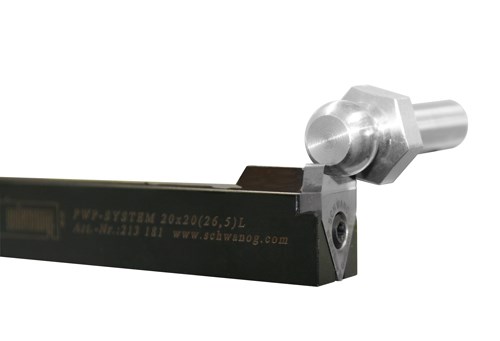The Skiving Solution
Shaving operations are often the solution for a shop that needs to produce round diameters and other tough contours with tolerances within ± 0.0005 inch.
Shaving operations are often the solution for a shop that needs to produce round diameters and other tough contours with tolerances within ± 0.0005 inch. This operation can provide an excellent surface finish prior to a thread rolling process. With a machine and toolholders that are in good condition, correctly ground tools, and appropriate speeds and feeds, shaving can deliver
the quality surface finish desired, and typically in fewer revolutions than an endworking operation.
But shaving has its limitations. Its attachment configuration uses an end slide with a roller to act as a counter balance, limiting its use to multi-spindle turning machines. While the counter guidance helps to maintain support as the cutting process decreases the diameter of the workpiece, the roller pushes the workpiece toward the cutting edge and creates additional stress on the cutting tool.
An alternative to shaving that can provide additional options is skiving. Suitable for parts that are long and slender, parts with close diameter tolerances and finishes, and parts requiring truly spherical radii, skiving can fill the gap where shaving leaves off. As with shaving, the skiving process provides a high quality surface finish by removing very minimal amounts of material after the roughing and finishing cuts.
Without the use of a counter roller, the skiving tool can be adapted to fit either single- or multi-spindle machines. The skiving process is similar in functionality to shaving; however, the cutting edge is only selectively in use during feeding, leading to a much lower cutting pressure. Part diameters are controlled by raising or lowering the skive tool instead of feeding the tool against a stop. Using proper cutting action, tool wear will not affect diameter dimensions. Carbide-tipped tools are typically used to obtain the best finishes.
Schwanog now offers a skiving system to assist manufacturers who are encountering technical limitations when trying to achieve tight tolerances and superior surface finishes. These skiving inserts are individually ground based on customer drawings and specifications. They are engineered to provide faster tool change-overs, high repeatability and tighter tolerances, resulting in an overall reduction of part costs relative to shaving or other surface finish tooling options.
Skiving’s flexibility allows feed rates to be increased by about 2 to 3 times for ferrous and difficult-to-machine materials. These adjustments offset the increased throw time required because of the lead angle.
Different from conventional tooling, skiving tools are mounted in such a way that the formed cutting edge of the tool is advanced into the workpiece below center, cutting tangentially. Raising the tool towards the center controls the part diameters, and the form is ground along the full length. This cutting process applies less pressure to the part to reduce premature part breakoff.
With the tangential cutting process, step differentials remain unchanged and angles do not need to be corrected. Without the need for diametral corrections, skiving allows the forming of a perfectly spherical radius on a workpiece.
Related Content
-
Parting Off: The Case for Standardizing on Sawing
The value of rotary saw cutting for parting off operations could boil down to simple economics paired with process efficiency gains.
-
Broaching Tool Technology For Lathes Used to Slot Inconel Parts
This shop finds value in using an indexable-insert-style broaching tool to create blind-hole slots in heat-treated Inconel aerospace parts on a CNC lathe.
-
Tool Path Improves Chip Management for Swiss-Type Lathes
This simple change to a Swiss-type turning machine’s tool path can dramatically improve its ability to manage chips.














.png;maxWidth=300;quality=90)



